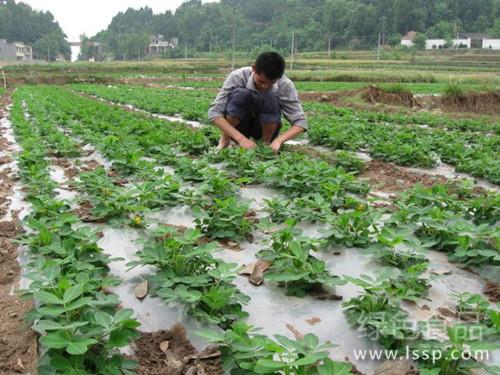Control methods of root rot lettuce lodging lettuce soft rot

Lettuce soft rot
First, harmful symptoms: lettuce Sclerotinia sclerotiorum soft rot is divided into root rot and stem base rot. Root rot type: after the root of lettuce is infected by Sclerotinia sclerotiorum, white hyphae are produced at the base of the stem, and a large number of small white particles are gradually formed, which overflows with water droplets, and then the small particles become black sclerotia, sometimes many sclerotia are connected into lumps, and the roots rot; stem base rot type: mainly infects the stem base, pathological changes occur at the base of the stem, young lettuce gets sick, the lower hyphae expands upward, the speed is fast, and the infected patients quickly become soft rot.
Second, the route of transmission and disease conditions: the sclerotia attached to the lettuce oversummer or overwintering, the sclerotia germinated new hyphae in the next spring, invaded from the root or stem base of lettuce, and gradually spread to the shoot. After lodging, the diseased plants were infected by contact with healthy plants. in the process of disease expansion, the hyphae produced a large number of sclerotia. Due to ploughing the land, the sclerotia fell into the soil and became the source of infection at the beginning of the next year.
3. Prevention and control methods:
(1) rotation of flood and drought, or rotation with other vegetables.
(2) it is reported abroad that Sclerotinia sclerotiorum can be effectively inhibited by Cladosporium gracilis, which can be demonstrated and popularized.
(3) selecting disease-resistant varieties, such as red leaf lettuce, shredded red, red round leaves with red color and resistance to Sclerotinia sclerotiorum, and heading lettuce, such as Wanli heart lettuce and crisp heart lettuce, can also resist Sclerotinia sclerotiorum.
(4) it is suitable to cultivate healthy seedlings at the age of 6 to 8 true leaves.
(5) promote compost made by Japanese enzyme bacteria or apply phosphate fertilizer 7.5~10kg and potassium fertilizer 10~15kg per mu, start topdressing lettuce after opening the plate, or spray 0.2% 0.5% compound fertilizer or 6000-fold solution to improve the disease resistance of lettuce.
(6) planting with soil to improve the quality of the film, make the film close to the ground and avoid the breeding of weeds.
(7) the black plastic film should be covered at the right time, and the unearthed vesicle disk should be blocked under the film, so that it can not get enough scattered light, can not complete the development process, and greatly reduce the probability of primary infection. Timely removal of diseased leaves, removal of diseased plants deeply buried, and combined with chemical control, but in the high temperature period to prevent plastic film heat absorption and burning seedlings, if necessary, sprinkle fine soil on the film, or watering to cool down, or postpone the planting period to avoid high temperature damage.
(8) in the early stage of the disease, start spraying 50% methyl thiophanate sulfur suspension or 50% propofol wettable powder 1000 times, 50% Sukeling or Nongliling wettable powder 1500 times, 40% sclerotia net wettable powder 1500 times, 20% methyl rifampicin EC 1000 times. Once every 7 to 10 days, prevention and treatment for 3 times in a row.
(9) lettuce cultivated in greenhouse can use smoke method or dust method, and stop using medicine 3 days before harvest.
- Prev

The method of applying soil and fertilizing Qinggu squatting Seedling to promote the Rapid growth of Peanut
The method of applying soil and fertilizing Qinggu squatting Seedling to promote the Rapid growth of Peanut
- Next

Control measures of abnormal zucchini affecting the appearance of zucchini
Control measures of abnormal zucchini affecting the appearance of zucchini
Related
- Fuxing push coffee new agricultural production and marketing class: lack of small-scale processing plants
- Jujube rice field leisure farm deep ploughing Yilan for five years to create a space for organic food and play
- Nongyu Farm-A trial of organic papaya for brave women with advanced technology
- Four points for attention in the prevention and control of diseases and insect pests of edible fungi
- How to add nutrient solution to Edible Fungi
- Is there any good way to control edible fungus mites?
- Open Inoculation Technology of Edible Fungi
- Is there any clever way to use fertilizer for edible fungus in winter?
- What agents are used to kill the pathogens of edible fungi in the mushroom shed?
- Rapid drying of Edible Fungi

